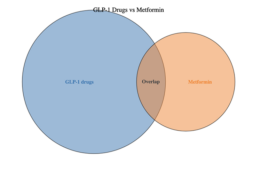The graphic above shows darker bubbles for companies with larger market caps as of March 25, 2024. Revenue and R&D spending figures are in USD. More data are available when hovering over a given company.
After a COVID-19 rebound in public perception and willingness to explore novel modalities, the pharma industry faces mounting pressures from tighter regulations and declining public trust. But despite these headwinds, Novo Nordisk (market cap: $576.5 billion) and Eli Lilly (market cap: $734.6 billion) have surged ahead of traditional industry giants like Pfizer ($155.3 billion), Johnson & Johnson ($374.1 billion), and Merck ($317.4 billion) in terms of market cap — in large part owing to their leadership position in metabolic disease.
Novo Nordisk’s and Eli Lilly’s performance is striking given the strong positive correlation between R&D spending and revenue. In 2023, Eli Lilly’s R&D spending as a percentage of revenue (R&D ratio) stood at 27.29%, while Novo Nordisk’s was significantly lower at 13.97%.
Lean R&D investments
Contrast that with Merck & Co., which spent more than half of its 2023 revenue on R&D thanks to its accounting of its Prometheus acquisition. Despite having lower overall revenues compared to industry behemoths and ranking in the middle tier among the top Big Pharmas in R&D investment, Novo Nordisk and Eli Lilly have demonstrated outstanding growth and efficiency in their operations.
In 2023, Eli Lilly’s revenue jumped by 19.6%, hitting $34.1 billion. Similarly, Novo Nordisk’s revenue jumped 34.8% to $33.7 billion. In contrast, the revenue growth rates of Johnson & Johnson Innovative Medicine and Merck & Co. were more muted at 4.2% and 1.4%, respectively, while Pfizer experienced a significant 41.7% decline from 2022 to 2023.
Eli Lilly’s and Novo Nordisk’s obesity focus could bode well for the firms, despite the market quickly growing more crowded with more than 100 pipeline drugs in the segment.
Goldman Sachs projects the obesity drugs market alone to expand 16-fold, reaching over $100 billion by 2030.
Novo and Lilly stand out in R&D efficiency
An analysis of pharma companies’ revenue and R&D spend from 2020-2023 highlights the link between R&D strategy and market capitalization. Eli Lilly, Novo Nordisk and Regeneron stand out, demonstrating a strong positive correlation between their R&D investments and their market value. Specifically, the analysis used a linear regression model based on R-squared (R²), a statistical tool that measures the relationship between two variables. Here, the value reflects the percentage of the variation in a company’s market value based on its R&D investment. An R² value of 1 implies a perfect fit, meaning R&D spend fully explains market cap changes, while a value of 0 indicates no relationship at all. A negative relationship implies that as companies ramp up their R&D investment, their market capitalization dips.
Complicating the analysis is the presence of a number of conglomerates, including J&J, Roche and GSK (prior to its Haleon consumer biz spin out).
The strategic emphasis placed by Eli Lilly and Novo Nordisk on the metabolic disease domain in recent years has allowed them to capture a growing share of the market, outpacing companies that have concentrated their efforts on more saturated areas such as oncology and inflammatory conditions. Previously, options for obesity were limited; GLP-1s fill this gap, making obesity one of the fastest growing market segments in pharma.
The R² values shown below highlight the strength and direction of the relationship between R&D spending and market capitalization for each company.
Promising drug pipelines
In addition to their current blockbuster therapies, Novo Nordisk and Eli Lilly boast strong drug pipelines. Eli Lilly’s Alzheimer’s antibody donanemab is one of the most anticipated potential approvals of 2024. In phase 3 trials, donanemab slowed cognitive decline by 35% and could hit blockbuster status if approved. The FDA has requested more safety data, delaying their decision. Lilly will need to compete with Eisai and Biogen’s Leqembi (lecanemab), which launched in 2023 but has seen a slower-than-expected rollout to date.
Meanwhile, Novo Nordisk is also expanding the indications for its GLP-1 based medications, exploring their potential in reducing inflammation associated with conditions such as Alzheimer’s and Parkinson’s. Meanwhile, Novo Nordisk is exploring novel uses for its GLP-1 based medications such as semaglutide (Ozempic), investigating their potential to reduce neuroinflammation in Alzheimer’s and Parkinson’s.
As Novo Nordisk and Lilly continue to maximize the impact of their R&D investments and expand into new therapeutic areas, their lean and focused approach could keep them at the helm of the pharma sector’s value creation in the coming years.
Filed Under: Metabolic disease/endicrinology



